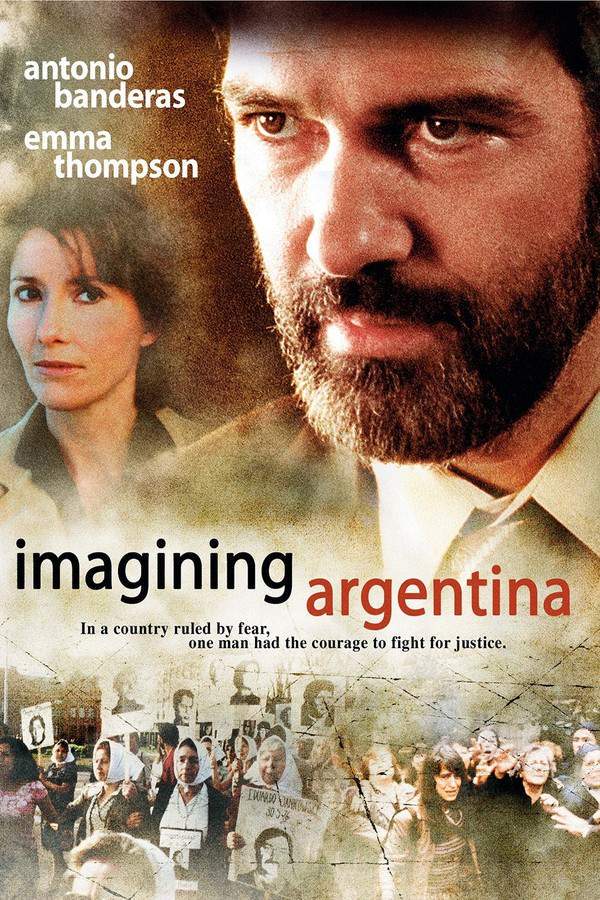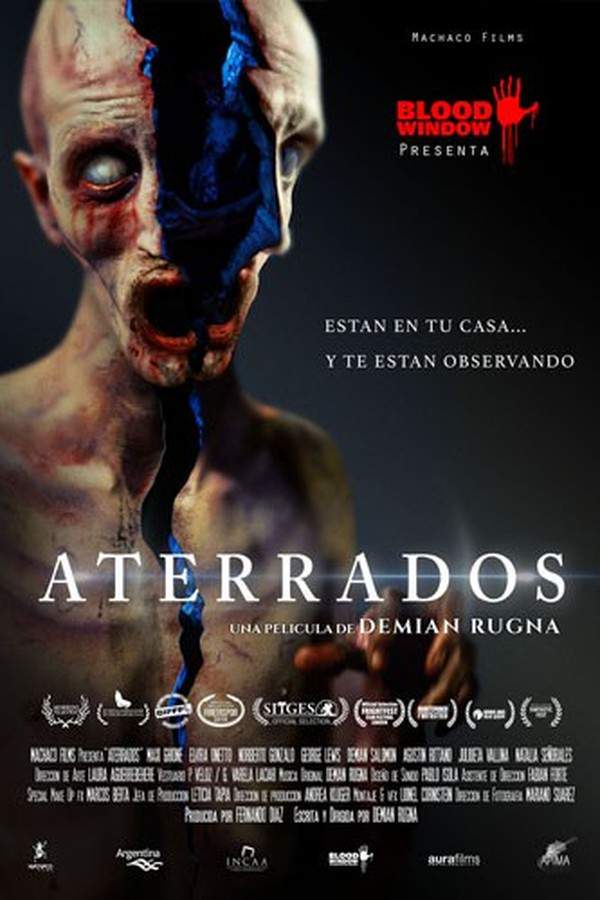
Imagining Argentina 2004
Directed by

Christopher Hampton
Made by

Arenas Entertainment
Test your knowledge of Imagining Argentina with our quiz!
Imagining Argentina Plot Summary
Read the complete plot summary and ending explained for Imagining Argentina (2004). From turning points to emotional moments, uncover what really happened and why it matters.
In A W Bergh, Stockholm, the narrative revolves around the notorious green Ford Falcons of Buenos Aires, infamous for being labeled as “death mobiles.” These vehicles executed sinister tasks for President Videla and a series of junta generals during the oppressive 1970s, emulating the horrifying tactics of dictator Pinochet just across the border in Chile. During this tumultuous period, innocent children protested against inflated school bus fares, only to vanish completely, a phenomenon known as desaparecidos. This dark chapter highlights how military personnel were trained to brutally suppress any opposition in Argentina’s dirty war that raged from the late 1970s into the early 80s.
The grim statistics speak volumes, with nearly 40,000 individuals succumbing to enforced disappearances until the military faced true combat against British forces during the Falklands conflict in 1982. This defeat marked the decline of military rule in Argentina, yet disturbingly, many of their accomplices continue to evade justice. The poignant image of grieving mothers endlessly circling the iconic Plaza de Mayo in Buenos Aires, holding up large portraits of their lost children, lingers as a testament to this tragic history.
Despite the heavy backdrop, Imagining Argentina presents a narrative that feels underwhelming, especially when compared to other significant films that convey similar themes. Costa-Gavras’s poignant work, Missing, took less than a decade to articulate the harrowing realities of Pinochet’s CIA-backed regime in Chile, showcasing a more incisive examination of the bloody coup. In contrast, the film’s protagonist, played by Antonio Banderas, attempts to harness voodoo to locate his missing wife and, tragically, his deceased daughter. His quest largely leads him across the vast Pampas, where he encounters an elderly Jewish couple with a peculiar hobby of tending to exotic birds. Their discussions center around the horrors of Nazi Germany, emphasizing a crucial, albeit limited, understanding of the long-standing military violence that plagued Latin America.
In essence, the film’s portrayal of the political climate comes across as shallow and misses the opportunity to delve deeply into the complexities of this historical context. The overall experience is disappointing enough that even notable critic Leonard Maltin overlooked its inclusion in his revered Movie Guide.
Imagining Argentina Timeline
Follow the complete movie timeline of Imagining Argentina (2004) with every major event in chronological order. Great for understanding complex plots and story progression.
Rise of the Junta
In the 1970s, military leaders in Argentina, inspired by the successful dictatorship of Pinochet in Chile, staged a coup. This led to the establishment of a brutal regime under President Videla, where dissent was met with violent suppression.
The Disappearances Begin
Under the military regime, thousands of people began to mysteriously disappear, a tactic referred to as 'desaparecidos.' Protesters, including young children opposing bus fare hikes, were taken away and often never seen again, creating a culture of fear in society.
Dirty War Escalates
The Dirty War intensified as the junta aimed to crush all opposition to their rule. The government conducted brutal tactics against perceived enemies, resulting in an estimated 40,000 individuals who vanished without a trace during this dark period.
The Falklands War
In 1982, the military faced a significant setback when they engaged British forces in the Falklands War. The conflict highlighted the weaknesses of the Argentine military, as they were swiftly defeated by a better-equipped British army.
Transition from Military Rule
Following the defeat in the Falklands, public sentiment turned against the military regime, leading to its eventual collapse. The fall of the junta marked the beginning of a new era for Argentina, aiming for democracy and accountability.
Mothers of Plaza de Mayo
In the wake of their disappearances, mothers of the victims began to gather weekly in Plaza de Mayo, demanding justice for their lost sons and daughters. Their peaceful protests became a powerful symbol of resistance against the military dictatorship.
Legacy of Violence
Even after the fall of the dictatorship, many of those responsible for the atrocities remained unpunished. The legacy of the Dirty War left deep scars, with many families still seeking justice for their desaparecidos, highlighting ongoing human rights issues.
Cultural Reflections
The narrative of the Dirty War and its impact on society was captured in the film 'Imagining Argentina', though it received criticism for being poorly executed. The film attempted to portray the emotional and political strife faced by families searching for lost loved ones.
Voodoo and Mysticism
In the midst of the chaos, a character utilizes voodoo to search for his missing wife. This plot element introduces a mystical approach to the real-life horrors of disappearance, reflecting the desperation of those left behind.
Connection to Nazi Germany
While searching for answers, the protagonist encounters an elderly couple who draw parallels between the Argentine junta's actions and the horrors of Nazi Germany. This encounter serves to highlight the historical patterns of state-sponsored violence and oppression.
International Awareness
Films like 'Missing', directed by Costa-Gavras, played a crucial role in bringing international attention to the atrocities committed in Argentina and Chile. Such works aimed to educate viewers about the consequences of U.S. foreign policies in Latin America during the Cold War.
Historical Reflection
As decades passed, the events of the Dirty War remained a significant chapter in Argentina's history. The struggles of families seeking closure and truth became crucial for the nation’s reconciliation process and understanding of its past.
Ongoing Struggle for Justice
To this day, many families continue to search for their loved ones, and humanitarian organizations advocate for the rights of victims. The commitment to memory and justice serves as a reminder of the importance of accountability and truth in a democratic society.
Imagining Argentina Characters
Explore all characters from Imagining Argentina (2004). Get detailed profiles with their roles, arcs, and key relationships explained.
Antonio Banderas
In 'Imagining Argentina', he portrays a clairvoyant who uses his abilities to search for his missing wife amid the chaos of political turmoil. His character embodies resilience and desperation, navigating the painful realities of a society torn apart by oppression while facing the personal loss of his family.
Imagining Argentina Settings
Learn where and when Imagining Argentina (2004) takes place. Explore the film’s settings, era, and how they shape the narrative.
Time period
1970s-1980s
The film is set during a tumultuous time in Argentina, marked by the military dictatorship from the late 1970s to the early 80s. This era was characterized by widespread human rights abuses, including forced disappearances of thousands of citizens, known as 'desaparecidos', who were targeted for speaking out against the regime.
Location
Buenos Aires, Pampas
Buenos Aires serves as the primary backdrop for 'Imagining Argentina', known for its rich cultural history but also infamous for the political repression during the military dictatorship. The Pampas, a vast grassland region, highlights the contrast between the urban struggles and the rural spaces, reflecting on the broader socio-political landscape of Argentina.
Imagining Argentina Themes
Discover the main themes in Imagining Argentina (2004). Analyze the deeper meanings, emotional layers, and social commentary behind the film.
🕊️
Political Oppression
The theme of political oppression permeates 'Imagining Argentina', showcasing the brutal actions of the military dictatorship and the impact on families and society. The portrayal of disappearances underscores the loss of freedom and the fight for justice against a backdrop of fear and silence.
💔
Loss and Grief
At its core, the film delves into the themes of loss and grief experienced by families of the disappeared. The journey of the protagonist reflects the deep emotional scars left by state violence, as he searches for his loved ones in a society gripped by mourning and unresolved trauma.

Coming soon on iOS and Android
The Plot Explained Mobile App
From blockbusters to hidden gems — dive into movie stories anytime, anywhere. Save your favorites, discover plots faster, and never miss a twist again.
Sign up to be the first to know when we launch. Your email stays private — always.
Imagining Argentina Spoiler-Free Summary
Discover the spoiler-free summary of Imagining Argentina (2004). Get a concise overview without any spoilers.
In the sweltering heat of 1970s Buenos Aires, a city cloaked in the quiet terror of an authoritarian regime, the air itself feels heavy with whispered rumors and unseen eyes. Streets pulse with a mix of ordinary life and a lingering sense that any dissent could vanish like mist. The film paints this era with a muted palette, letting the ever‑present hum of military patrols and the occasional, distant protest echo through every frame, creating a world where hope and fear coexist in a fragile balance.
Celia is a journalist whose fierce pen cuts through the propaganda that suffocates the nation. Her courage in speaking truth to power makes her both a beacon for those who yearn for justice and a target for a regime that tolerates no opposition. Her husband, Carlos, is a quietly resilient man whose love for her turns into an all‑consuming quest when she disappears. Haunted by unsettling visions that blur the line between waking and dreaming, he carries the weight of a private nightmare while the public climate grows ever darker.
The film’s tone is both intimate and expansive, moving from the cramped, dimly lit rooms where Carlos pores over clues to the vast, open Pampas that seem to swallow sound and sense alike. A lingering melancholy pervades each scene, underscored by a soundtrack that weaves traditional folk whispers with disquieting, almost otherworldly tones. Through restrained performances and careful cinematography, the story invites the audience to feel the suffocating uncertainty that defines everyday life under oppression.
As Carlos confronts the void left by Cecilia’s absence, his determination sharpens, especially when the disappearance threatens their child as well. The narrative balances the stark reality of political repression with an almost surreal personal journey, leaving viewers rooted in a world where love battles a relentless, unseen force, and every step forward is fraught with both dread and a stubborn spark of hope.
Can’t find your movie? Request a summary here.
Movies with Similar Twists and Themes
Uncover films that echo the narrative beats, emotional arcs, or dramatic twists of the one you're exploring. These recommendations are handpicked based on story depth, thematic resonance, and spoiler-worthy moments — perfect for fans who crave more of the same intrigue.
Featured on this page

What's After the Movie?
Not sure whether to stay after the credits? Find out!
Explore Our Movie Platform
New Movie Releases (2025)
Famous Movie Actors
Top Film Production Studios
Movie Plot Summaries & Endings
Major Movie Awards & Winners
Best Concert Films & Music Documentaries
Movie Collections and Curated Lists
© 2025 What's After the Movie. All rights reserved.












